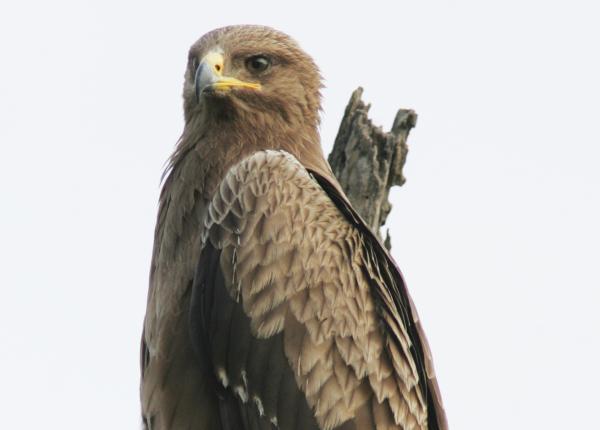Did You Know?
- The Lesser Spotted Eagle uses at least three different hunting techniques: it will sit on a perch, watching and waiting; it will soar in search of prey before diving down to trap it, or it will walk along the ground in search of something good to eat.
- To date, the oldest banded Lesser Spotted Eagle is 26 years old.
How The Peregrine Fund is Helping
The Peregrine Fund is not working directly with Lesser Spotted Eagles, but our conservation efforts through habitat protection, education, and community outreach extend to all raptor species, including this eagle. We also supply literature to researchers from our avian research library, which helps scientists around the world gather and share important information on raptor conservation. We also run the Global Raptor Impact Network which gives raptor researchers tools to more efficiently conduct their own studies while contributing to a global program. GRIN also provides citizen scientists a way to participate in raptor science and conservation.
Where it Lives
The Lesser Spotted Eagle is found in parts of Europe and the Middle East and overwinters in parts of Africa. It is found in a myriad of different habitats including moist lowland forests, often near wetlands, dry upland forest, forest-steppes, river valleys, and the periphery of wet meadows. Birds that overwinter in Africa are found in wetter woodland areas, in general.
What it Does
These migratory raptors are usually found singly or in small flocks. However, in winter in Africa, this species is often found in large numbers with Steppe Eagles and Wahlberg's Eagles. This species has been known to breed with Greater Spotted Eagles.
Why it Needs our Help
This eagle is categorized as a species of Least Concern. However, that doesn't mean that this species still faces many threats. Habitat degradation through deforestation and the draining of wetlands is having an impact on this species. Sadly, so is poaching. It is estimated that 100's or even 1,000's might be shot every year during their migration.
What it Eats
The Lesser Spotted Eagle has a varied diet. This highly migratory species feeds on different prey based on where it is. When it is on its breeding grounds, it tends to favor mammals as its primary food source. It will hunt ground squirrels, rats, mice, and voles. However, like most other predators, it will take other prey items when it can. It will feed on medium-sized birds, frogs, lizards, snakes, and insects. In its wintering range, the bulk of its diet consists of Red-billed Quelea nestlings and termites though it will also take other prey items. It is known to occasionally feed on carrion.
Nests, Eggs, and Young
The Lesser Spotted Eagle normally nests high in trees, though once in a while they do nest on the ground. They build a stick nest that is quite large, that can measure between 50–150 cm in diameter. The nest is lined with green twigs and even grass.
The female will lay 1-2 eggs, which must be incubated for about 5 weeks. After the nestlings hatch, they are covered in a gray-white down. When food is very abundant, both young will often survive to fledging. However, most often, only one young survives. This is because one nestling - usually the older, bigger one - kills its younger sibling. This is called cainism. Whether one or two young survive, they will fledge, or fly for the first time, at around 8 weeks of age.
Lesser Spotted Eagles reach sexual maturity when they are between 3-4 years old.
Lesser Spotted Eagle and the World Center for Birds of Prey
The World Center for Birds of Prey offers fun ways to learn about raptors of all kinds. Interactive activities, tours, interesting videos, and a children's room with activities from coloring sheets and quizzes to costumes and a touch table are available for the curious mind. We also have several different birds of prey on display year-round, including several eagle species! Though we don't have any resident Lesser Spotted-Eagles at the World Center for Birds of Prey, if you visit you will be rewarded with an opportunity to meet Fancy, our resident Ornate Hawk-eagle, a beautiful Bald Eagle, and Grayson a Harpy Eagle. At the visitor center, you will see these amazing birds of prey, and others, up close in our outdoor aviary. Our knowledgeable staff is on hand to answer any questions you may have.
References:
Global Raptor Information Network. 2022. Species account: Lesser Spotted Eagle Lophaetus pomarinus. Downloaded from http://www.globalraptors.org on 26 Dec. 2022
Meyburg, B.-U., P. F. D. Boesman, J. S. Marks, and G. M. Kirwan (2020). Lesser Spotted Eagle (Clanga pomarina), version 1.0. In Birds of the World (J. del Hoyo, A. Elliott, J. Sargatal, D. A. Christie, and E. de Juana, Editors). Cornell Lab of Ornithology, Ithaca, NY, USA. https://doi.org/10.2173/bow.leseag1.01









